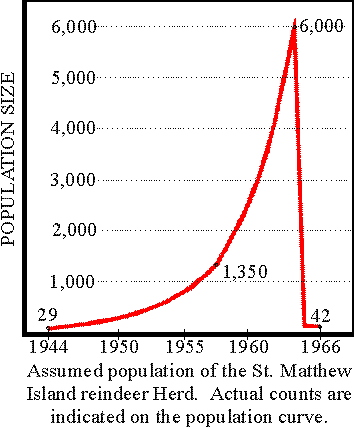The truth is especially hard to believe if it requires that we take action – if it requires that we change. If humanity is to have a future, we must take action – we must change. If humanity is to have a future, we must believe the truth.
Jay Hanson chose the name DIEOFF for his website as a warning to humanity of the impending Fossil Fuel Depletion Over Population Crisis. Dieoff is not a political term, it comes from science. This morning two excellent scientists explain what it means.
Preview of Coming Attractions: A Reindeer’s Tale
David R. Klein
Reindeer (Rangifer tarandus), introduced to St. Matthew Island in 1944, increased from 29 animals at that time to 6,000 in the summer of 1963 and underwent a crash die-off the following winter to less than 50 animals. In 1957, the body weight of the reindeer was found to exceed that of reindeer in domestic herds by 24 53 percent among females and 46 61 percent among males. The population also responded to the high quality and quantity of the forage on the island by increasing rapidly due to a high birth rate and low mortality. By 1963, the density of the reindeer on the island had reached 46.9 per square mile and ratios of fawns and yearlings to adult cows had dropped from 75 and 45 percent respectively, in 1957 to 60 and 26 percent in 1963. Average body weights had decreased from 1957 by 38 percent for adult females and 43 percent for adult males and were comparable to weights of reindeer in domestic herds. Lichens had been completely eliminated as a significant component of the winter diet. Sedges and grasses were expanding into sites previously occupied by lichens. In the late winter of 196364, in association with extreme snow accumulation, virtually the entire population of 6,000 reindeer died of starvation. With one known exception, all of the surviving reindeer (42 in 1966) were females. The pattern of reindeer population growth and die-off on St. Matthew Island has been observed on other island situations with introduced animals and is believed to be a product of the limited development of ecosystems and the associated deficiency of potential population-regulating factors on islands. Food supply, through its interaction with climatic factors, was the dominant population regulating mechanism for reindeer on St. Matthew Island.

St. Matthew Island, 128 square miles in area and located in the Bering Sea Wildlife Refuge in the north central Bering Sea (Fig. 1), supports a poorly developed land fauna. Native land mammals are restricted to a vole (Microtus abbreviatus) and the arctic fox ( Alopex lagopus ), although a resident population of polar bears (Thalarctos maritimus) existed there in Recent times (Elliot 1882). The reindeer on St. Matthew Island were the result of the release of 24 females and 5 males on August 20, 1944, by the U. S. Coast Guard (Klein 1959). Shortly afterwards, the Coast Guard loran station on the island was abandoned and the island has been uninhabited since then. Specimens taken for study purposes and those shot by Coast Guard personnel as a recreational pursuit have been the only harvest from the herd. With the exception of 10 in 1966, these were all taken during 1957-63 and totaled 105 animals. This paper reports on the population dynamics and range interrelationships of this island reindeer herd from the time of introduction through its rapid increase and crash die-off until July, 1966.
Easter’s End
by Jared Diamond
In just a few centuries, the people of Easter Island wiped out their forest, drove their plants and animals to extinction, and saw their complex society spiral into chaos and cannibalism. Are we about to follow their lead?
Among the most riveting mysteries of human history are those posed by vanished civilizations. Everyone who has seen the abandoned buildings of the Khmer, the Maya, or the Anasazi is immediately moved to ask the same question: Why did the societies that erected those structures disappear?
Their vanishing touches us as the disappearance of other animals, even the dinosaurs, never can. No matter how exotic those lost civilizations seem, their framers were humans like us. Who is to say we won´t succumb to the same fate? Perhaps someday New York´s skyscrapers will stand derelict and overgrown with vegetation, like the temples at Angkor Wat and Tikal.
Among all such vanished civilizations, that of the former Polynesian society on Easter Island remains unsurpassed in mystery and isolation. The mystery stems especially from the island´s gigantic stone statues and its impoverished landscape, but it is enhanced by our associations with the specific people involved: Polynesians represent for us the ultimate in exotic romance, the background for many a child´s, and an adult´s, vision of paradise. My own interest in Easter was kindled over 30 years ago when I read Thor Heyerdahl´s fabulous accounts of his Kon-Tiki voyage.
But my interest has been revived recently by a much more exciting account, one not of heroic voyages but of painstaking research and analysis. My friend David Steadman, a paleontologist, has been working with a number of other researchers who are carrying out the first systematic excavations on Easter intended to identify the animals and plants that once lived there. Their work is contributing to a new interpretation of the island´s history that makes it a tale not only of wonder but of warning as well.